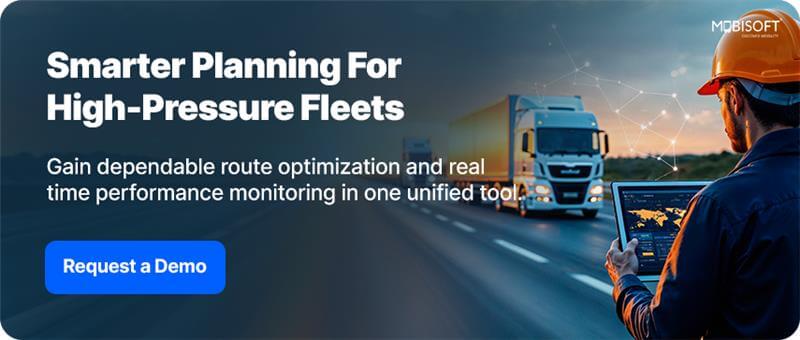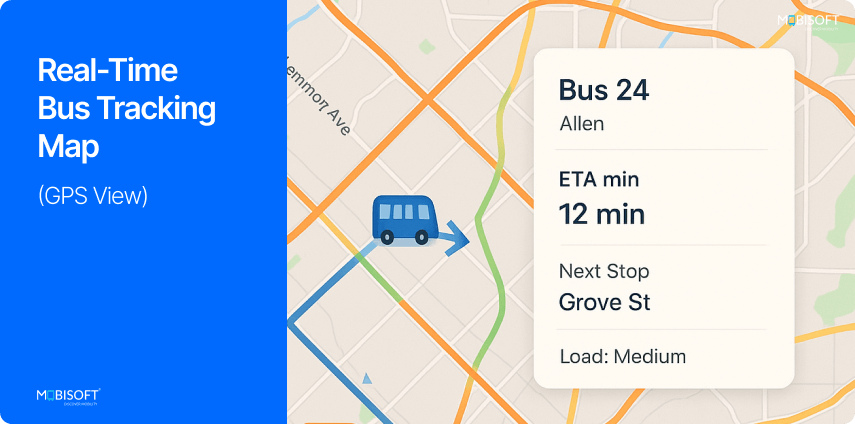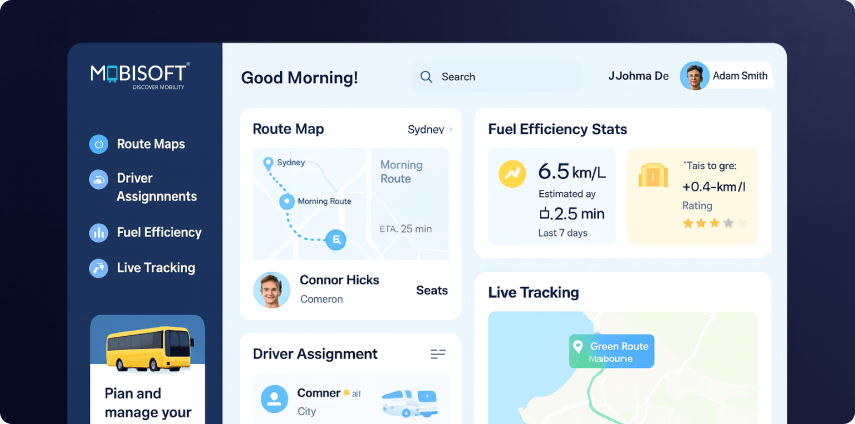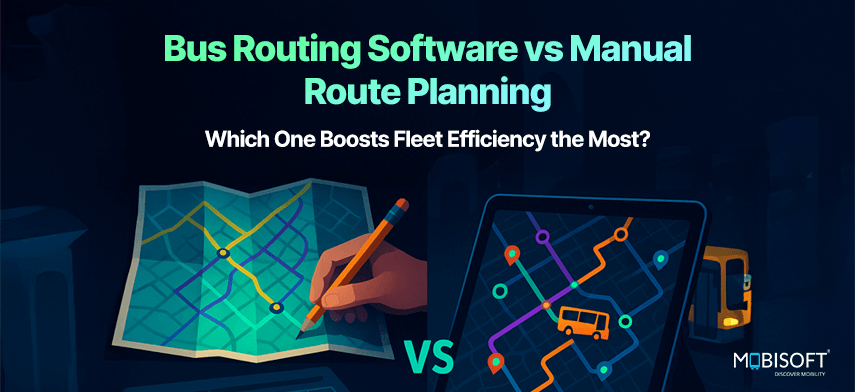Fleet operations often appear simple and efficient from a distance. Behind it, however, lie inefficiencies that consume fuel, effort, and most importantly, time. These issues usually go unnoticed, causing long-term damage. By the time audits are conducted and discrepancies are found, damage is already done. The problem isn't a lack of hard work, but the built-in limits of manual route planning in a world driven by data.
When accuracy, timing, and cost efficiency define success, relying on intuition becomes an operational risk. This discussion extends beyond digital maps or routing tools. It’s about establishing a responsive, analytics-powered framework where decisions are driven by intelligence rather than improvisation.
The real question is no longer whether bus routing software can optimize routes, but whether your existing process can sustain the precision and scalability modern fleet operations require.
Explore how a powerful route optimization solution can support smarter and more scalable routing decisions.
Why Manual Bus Route Planning Costs More

Expertise Bottleneck
People praise experience, rightfully so. But experience kept in one's head is fragile. The expertise bottleneck means that if that person is sick, leaves, or retires early, the process collapses. That knowledge lives in mental notes, sticky memos, and a folder labeled “Master Routes,” which is ironic because nothing about it feels masterful when disruption hits.
Micro-cost Accumulation
Manual planning misses the compounding micro-costs. For example, A left turn on a busy road, ten seconds of idling at a signal, or five extra stops squeezed into one morning route. These sure look insignificant, but add them over months and they become fuel expense, overtime, and wear on vehicles. Nobody set out to waste money. It happened in small, human increments.
Complexity Overload
A road closure can create a domino effect. Rerouting one bus requires redrawing the whole plan, recalculating times, calling drivers, and updating parents or riders. That takes hours. Sometimes an entire day. Growth makes that worse. Add one bus to a network, and the planner’s cognitive load increases exponentially. Complexity multiplies, not linearly, and very soon you’re paying for an architect of exceptions, rather than a strategic operator, an issue avoided with fleet routing software.
Learn how a modern transportation management system helps fleets overcome these operational bottlenecks.

How Route Optimization Software Boosts Efficiency

Call software a map if you must, but that understates what it does. Modern systems are optimization engines. They evaluate thousands of variables at once, score trade-offs, and select options that humans would not discover without spending unreasonable time and energy the exact reason fleets adopt route optimization software.
Route Optimization
At the core, algorithms test possibilities. They factor vehicle specs, passenger numbers, driver hours, mean traffic patterns, and historical delays, then they generate plans that meet constraints while minimizing costs. They do more than find a path. They find an efficient allocation of limited resources true dynamic route optimization at work.
Real-time Re-routing
When an incident happens, the system recalculates and pushes new instructions to driver tablets. That cuts confusion, and it reduces the cascade of delays. Drivers get clear next steps, dispatchers get fewer frantic calls, and passengers see fewer surprises improved through real-time route optimization features.
Data-driven Insights
Software also mines data to reveal how capacity is used. Passenger patterns can reveal hidden chances: merge stops with overlap during slow hours, shift start times slightly to gain steady punctuality, or move vehicles to match busy periods better. These steps can cut down the total vehicles needed, pushing back the need for expensive new purchases.
Predictive Analysis
When historical traffic, school calendars, or weather patterns suggest likely delay windows, planners can preemptively alter schedules. That means fewer reactive fixes and more predictable operations. Predictable days improve driver retention, and predictable routes keep customers coming back, a key advantage of fleet route planning software.
See how smart systems for bus fleet operators enhance real-time routing and improve daily performance.
The Real ROI: Measuring Impact Beyond Fuel Savings

Tech leaders ask for numbers. They want clear returns, not slogans. So let’s talk metrics, and then the softer wins that still affect the bottom line.
Hard metrics to track:
- Cost per mile, which wraps fuel, maintenance, and depreciation into a single efficiency metric. Lower that and you're free to budget for other priorities.
- Vehicle utilization rate. Better routes mean each bus works more, not harder, deferring replacement investments.
- Labor hours saved. When planners stop fighting fires, overtime drops. When drivers follow clearer schedules, late arrivals fall.
These are measurable and meaningful. But soft metrics matter too, because they drive durable benefits. They include:
Passenger Satisfaction
Customers appreciate reliable ETAs and shorter ride times. For school runs, that equals parental trust and fewer complaints. For transit fleets, reliability boosts ridership and fare revenue often achieved with bus route planning software.
Driver Satisfaction
When days feel less chaotic, drivers feel more confident. Drivers who trust the schedule and the support system stay longer. Retention is cheaper than hiring, especially when hiring is scarce.
Sustainability
Reducing idling and extra miles reduces emissions. That is a metric you can report for ESG goals, and it is something stakeholders and regulators increasingly expect.
Discover how transportation and logistics industry solutions can strengthen operational efficiency at scale.
Planners as Strategic Analysts in Fleet Management

Nobody is out to cut planners’ jobs. The reality is the planner’s role evolves, and in practical terms, that is a promotion. Software handles repetitive optimization. Humans apply judgment, manage exceptions, and make decisions that require context beyond the data.
Planners become analysts, interpreting reports and focusing on improvement cycles. They tune policies, manage driver performance, and liaise with customers. They think about electrification, depot placement, or contract modeling because the system frees them from line-by-line route drawing, especially with tools like fleet management routing software and automated route planning.
Quirks, such as the house with a long driveway, the low-clearance underpass, should be inputs instead of surprises. A good system lets you encode those constraints, so the algorithm’s output respects on-the-ground realities. This is human plus machine, not human versus machine. It’s a collaboration, and it gets better outcomes.
Explore how fleet and logistics technology solutions help teams shift from manual planning to strategic fleet management.
How to Effectively Roll Out Route Planning Software?
This is where a good idea meets the reality of budgets and approvals. To progress, you need a workable plan that convinces the decision-makers who view the world through spreadsheets and profit margins.
Step 1: Take a Snapshot of Now
- Before anything else, gather your numbers. What's your average monthly fuel spend? How many minutes pile up on each route?
- Track the hours your planners lose to endless schedule tweaks. Count the overtime incidents and measure vehicle idle time.
- Aim at building your "before" picture, the undeniable baseline that will later prove your success with fleet route optimization solutions.
Step 2: Decide What Winning Looks Like
- Be specific about your goals. Pick a few key numbers that will make your CFO smile.
- Maybe you're aiming for a ten percent drop in cost per mile. Perhaps a fifteen percent leap in on-time performance is the real prize.
- Choose targets that are ambitious but also grounded. Realistic goals build trust.
Step 3: Start with a Test Drive
- Don't try to tackle everything at once. Instead, start a test run with a few buses or certain routes.
- This shows the idea works with your own data and staff. It allows you to smooth out any issues in your systems.
- A successful pilot creates internal champions, and that is pure gold, especially when demonstrating the shift from manual vs automated route planning.
Step 4: Pick a Partner, Not Just a Product
- Look beyond the price tag, ask harder questions. How well will their system talk to your existing telematics and payroll?
- What is their customer support really like when you have a crisis at 5 a.m.? Scrutinize their security posture.
- Ask for references from organizations that mirror your own fleet's size and challenges using route optimization for transportation tools.
Step 5: Bring Your People Along
- This might be the most important step because adapting to new tools can feel difficult.
- Train your planners thoroughly by involving your drivers early in the process, listening to their feedback.
- Communicate the changes to passengers or parents. When people feel part of the process, they stop fighting and start helping.
- Show them a quick success, and you'll change doubters into supporters.
Get a closer look at how an automated bus route planning software supports smoother rollout and adoption, now linked to school bus tracking and routing.
Ensuring Smooth Operations Through Smarter Routing
Let's be honest, manual planning worked for a long time. It was a different world. But growth has a way of complicating things. What once felt sturdy can become fragile, too dependent on one person's knowledge and too slow to react to daily surprises, limitations that bus routing software vs manual planning highlights clearly.
So train your team, and integrate your data. Feed those local quirks into the system so the technology understands your real-world challenges. Sure, there will be a learning curve. There always is. But the total benefits, the quiet boost in productivity that builds up over time, make up for the work you put in at the start.
When you can predict your daily work and base your choices on clear facts, something great happens. Your profits start to look a bit better. And your big-picture decisions? They become much more exciting.
See how ongoing improvements are supported by a fleet management and routing platform built for modern operations, now linked to digital transformation in transportation
Key Takeaways
- Manual planning fails without anyone noticing, resulting in substantial wastage of time, money, and accuracy, clear proof of route planning vs route optimization gaps.
- Predictive analysis changes reactive scheduling into proactive planning, which makes daily operations run more predictably.
- When vehicles, data, and human know-how work together as one, it leads to enhanced results supported by fleet efficiency optimization.
- Planners go from simply drawing lines to shaping strategy using data to make smarter and quicker choices.
- Real-time routing doesn’t just save minutes; it restores calm to dispatch centers and confidence to drivers through real-time route optimization.
- Cost per mile, utilization rate, and labor hours become living metrics that improve continuously.
- The right software partner isn’t a vendor, it’s a collaborator that scales with your fleet’s future demands.
- When teams feel part of the process, technology adoption stops being resistance and starts being momentum.
For more insights, explore how automation in bus operations is reshaping routing efficiency across the industry.

FAQs
How do manual planning gaps quietly drain profitability?
Small inefficiencies don’t make noise, but they add up. A few extra turns, slight detours, or idle minutes multiply into fuel loss, overtime, and customer complaints. Software uncovers these invisible leaks early, long before they show up in monthly reports.
What makes route optimization software smarter than digital maps?
A map shows roads. Optimization software interprets them. It studies how vehicles, time, and constraints interact, then proposes routes that balance speed, cost, and capacity. It’s logic layered with real-world behavior, not just pins and paths.
How does automation change the planner’s daily routine?
The routine becomes more strategic. Instead of tweaking endless routes, planners focus on exceptions, analyze trends, and fine-tune performance. The work feels less reactive and more like managing a live, intelligent system that learns from every trip.
Can predictive routing really prevent disruptions before they occur?
Yes, and that’s where the real power lies. By reading patterns in past traffic, weather, and events, it flags problem windows before they hit. Planners can preempt delays, making operations calmer and timetables more reliable.
What signs suggest a fleet has outgrown manual planning?
When route changes start taking days instead of hours. When one person’s absence slows everything down. When the cost per mile climbs despite the same routes. Those are red flags that manual systems are no longer keeping pace.
How does smarter routing influence long-term fleet costs?
Better routing stretches every asset’s life. Vehicles run fewer wasteful miles, maintenance cycles stabilize, and replacement plans can be delayed. Over time, those gains compound, turning routing efficiency into real capital savings.
Why does driver experience matter in optimization?
Because drivers live the routes every day. When their input feeds the system, it reflects ground reality more accurately. Fewer wrong turns, fewer last-minute calls, and better morale. Its efficiency is built on respect for lived experience.




 October 20, 2025
October 20, 2025


